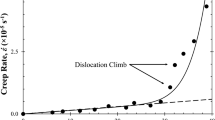Abstract
To ensure reliable design of soldered interconnections as electronic devices become smaller, requires greater knowledge and understanding of the relevant mechanical behavior of solder alloys than are presently available. The present paper reports the findings of an investigation into the monotonic tensile properties of bulk samples of three solder alloys; a lead–tin eutectic and two lead-free solders (tin–3.5 copper and a tin–3.5 silver alloy). Temperatures between−10 and 75°C and strain rates between 10−1 and 10−3 s−1 have been studied. Both temperature and strain rate may have a substantial effect on strength, producing changes well in excess of 100%. Strength is reduced by lowering strain rate and increasing temperature, and Sn–37 Pb is usually most sensitive to the latter. Expressions for strain and strain rate hardening have been developed. The Sn–0.5 Cu alloy is usually the weakest and most ductile. Sn–37 Pb is strongest at room temperature but with increasing temperature and lower strain rates it becomes inferior to Sn–3.5 Ag. Ductility changes with temperature and strain rate for all three alloys are generally small with inconsistent trends. The role of such data in stress analysis and modeling is considered and the paramount importance of employing data for conditions appropriate to service, is emphasized.
Similar content being viewed by others
References
B. I. Sandor, in “Solder MechanicsÐA State of the Art Review,” edited by D. R. Frear, W. B. Jones and K. R. Kinsman (TMS, EMPMD Monograph Series 1, Warrendale, Pennsylvania, 1991) p. 363.
D. R. Frearm, S. N. Buchett, M. K. Neilson and J. J. Stephens, Solder. Surf. Mount Technol. 25 (1997) 39.
C. Bailey, D. Wheeler and M. Cross, ibid. 10 (1998) 6.
W. J. Plumbridge, J. Mater. Sci. 3 (1996) 2501.
J. H. Holloman, Trans Am. Inst. Mining, Metall Petrol. Eng 162 (1945) 268.
W. K. Jones, Y. Liu, M. A. Zampino, G. Gonzalez and M. Shah, in “Design and Reliability of Solders and Solder Interconnections” (TMS, Warrendale, Pennsylvania, 1997) p. 85.
Author information
Authors and Affiliations
Rights and permissions
About this article
Cite this article
Plumbridge, W.J., Gagg, C.R. Effects of strain rate and temperature on the stress–strain response of solder alloys. Journal of Materials Science: Materials in Electronics 10, 461–468 (1999). https://doi.org/10.1023/A:1008930430875
Issue Date:
DOI: https://doi.org/10.1023/A:1008930430875




